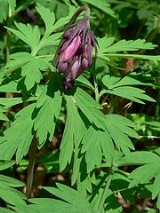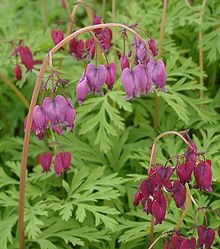
Dicentra formosa
Encyclopedia
Dicentra formosa is a herbaceous
perennial
growing from a rhizome
, native to moist woodland
from California
to British Columbia
.
are finely divided and fern
like, growing from the base of the plant.
Flower
s are pink, red, or white and heart-shaped and bloom in clusters at the top of leafless, fleshy stems above the leaves from mid-spring
to autumn
, with peak flowering in spring. The four petal
s are attached at the base. The two outer petal
s form a pouch at the base and curve outwards at the tips. The two inner petals are perpendicular to the outer petals and connected at the tip. There are two tiny, pointed sepal
s behind the petals.
Seed
s are borne in plump, pointed pods
.
The plant frequently goes dormant
for the summer
after flowering, emerging and flowering again in autumn
.
, which has narrower flowers and longer, more curved outer petal tips.
:
 There are several cultivars and hybrid cultivars involving Dicentra eximia
There are several cultivars and hybrid cultivars involving Dicentra eximia
and Dicentra peregrina
.
Dicentra formosa
Hybrids
Herbaceous plant
A herbaceous plant is a plant that has leaves and stems that die down at the end of the growing season to the soil level. They have no persistent woody stem above ground...
perennial
Perennial plant
A perennial plant or simply perennial is a plant that lives for more than two years. The term is often used to differentiate a plant from shorter lived annuals and biennials. The term is sometimes misused by commercial gardeners or horticulturalists to describe only herbaceous perennials...
growing from a rhizome
Rhizome
In botany and dendrology, a rhizome is a characteristically horizontal stem of a plant that is usually found underground, often sending out roots and shoots from its nodes...
, native to moist woodland
Woodland
Ecologically, a woodland is a low-density forest forming open habitats with plenty of sunlight and limited shade. Woodlands may support an understory of shrubs and herbaceous plants including grasses. Woodland may form a transition to shrubland under drier conditions or during early stages of...
from California
California
California is a state located on the West Coast of the United States. It is by far the most populous U.S. state, and the third-largest by land area...
to British Columbia
British Columbia
British Columbia is the westernmost of Canada's provinces and is known for its natural beauty, as reflected in its Latin motto, Splendor sine occasu . Its name was chosen by Queen Victoria in 1858...
.
Description
LeavesLeaf
A leaf is an organ of a vascular plant, as defined in botanical terms, and in particular in plant morphology. Foliage is a mass noun that refers to leaves as a feature of plants....
are finely divided and fern
Fern
A fern is any one of a group of about 12,000 species of plants belonging to the botanical group known as Pteridophyta. Unlike mosses, they have xylem and phloem . They have stems, leaves, and roots like other vascular plants...
like, growing from the base of the plant.
Flower
Flower
A flower, sometimes known as a bloom or blossom, is the reproductive structure found in flowering plants . The biological function of a flower is to effect reproduction, usually by providing a mechanism for the union of sperm with eggs...
s are pink, red, or white and heart-shaped and bloom in clusters at the top of leafless, fleshy stems above the leaves from mid-spring
Spring (season)
Spring is one of the four temperate seasons, the transition period between winter and summer. Spring and "springtime" refer to the season, and broadly to ideas of rebirth, renewal and regrowth. The specific definition of the exact timing of "spring" varies according to local climate, cultures and...
to autumn
Autumn
Autumn is one of the four temperate seasons. Autumn marks the transition from summer into winter usually in September or March when the arrival of night becomes noticeably earlier....
, with peak flowering in spring. The four petal
Petal
Petals are modified leaves that surround the reproductive parts of flowers. They often are brightly colored or unusually shaped to attract pollinators. Together, all of the petals of a flower are called a corolla. Petals are usually accompanied by another set of special leaves called sepals lying...
s are attached at the base. The two outer petal
Petal
Petals are modified leaves that surround the reproductive parts of flowers. They often are brightly colored or unusually shaped to attract pollinators. Together, all of the petals of a flower are called a corolla. Petals are usually accompanied by another set of special leaves called sepals lying...
s form a pouch at the base and curve outwards at the tips. The two inner petals are perpendicular to the outer petals and connected at the tip. There are two tiny, pointed sepal
Sepal
A sepal is a part of the flower of angiosperms . Collectively the sepals form the calyx, which is the outermost whorl of parts that form a flower. Usually green, sepals have the typical function of protecting the petals when the flower is in bud...
s behind the petals.
Seed
Seed
A seed is a small embryonic plant enclosed in a covering called the seed coat, usually with some stored food. It is the product of the ripened ovule of gymnosperm and angiosperm plants which occurs after fertilization and some growth within the mother plant...
s are borne in plump, pointed pods
Capsule (fruit)
In botany a capsule is a type of simple, dry fruit produced by many species of flowering plants. A capsule is a structure composed of two or more carpels that in most cases is dehiscent, i.e. at maturity, it splits apart to release the seeds within. A few capsules are indehiscent, for example...
.
The plant frequently goes dormant
Dormancy
Dormancy is a period in an organism's life cycle when growth, development, and physical activity are temporarily stopped. This minimizes metabolic activity and therefore helps an organism to conserve energy. Dormancy tends to be closely associated with environmental conditions...
for the summer
Summer
Summer is the warmest of the four temperate seasons, between spring and autumn. At the summer solstice, the days are longest and the nights are shortest, with day-length decreasing as the season progresses after the solstice...
after flowering, emerging and flowering again in autumn
Autumn
Autumn is one of the four temperate seasons. Autumn marks the transition from summer into winter usually in September or March when the arrival of night becomes noticeably earlier....
.
Similar species
This species is frequently confused with and sold as Dicentra eximiaDicentra eximia
Dicentra eximia is a herbaceous perennial growing from rhizomes, native to rocky woodland and bases of cliffs in the Appalachians from Pennsylvania south.-Description:...
, which has narrower flowers and longer, more curved outer petal tips.
Subspecies
There are two subspeciesSubspecies
Subspecies in biological classification, is either a taxonomic rank subordinate to species, ora taxonomic unit in that rank . A subspecies cannot be recognized in isolation: a species will either be recognized as having no subspecies at all or two or more, never just one...
:
- Dicentra formosa subsp. formosa — leaves glaucous beneath and never glaucous above, flowers purple pink to pink or white
western slope of Sierra Nevada, Coast RangesPacific Coast RangesThe Pacific Coast Ranges and the Pacific Mountain System are the series of mountain ranges that stretch along the West Coast of North America from Alaska south to Northern and Central Mexico...
to central CaliforniaCaliforniaCalifornia is a state located on the West Coast of the United States. It is by far the most populous U.S. state, and the third-largest by land area...
, CascadesCascade RangeThe Cascade Range is a major mountain range of western North America, extending from southern British Columbia through Washington and Oregon to Northern California. It includes both non-volcanic mountains, such as the North Cascades, and the notable volcanoes known as the High Cascades...
, extreme southwestern British ColumbiaBritish ColumbiaBritish Columbia is the westernmost of Canada's provinces and is known for its natural beauty, as reflected in its Latin motto, Splendor sine occasu . Its name was chosen by Queen Victoria in 1858... - Dicentra formosa subsp. oregona (often spelled oregana) — leaves glaucous above and beneath, flowers cream or pale yellow
small area of northwestern CaliforniaCaliforniaCalifornia is a state located on the West Coast of the United States. It is by far the most populous U.S. state, and the third-largest by land area...
and southwestern OregonOregonOregon is a state in the Pacific Northwest region of the United States. It is located on the Pacific coast, with Washington to the north, California to the south, Nevada on the southeast and Idaho to the east. The Columbia and Snake rivers delineate much of Oregon's northern and eastern...
Cultivars

Dicentra eximia
Dicentra eximia is a herbaceous perennial growing from rhizomes, native to rocky woodland and bases of cliffs in the Appalachians from Pennsylvania south.-Description:...
and Dicentra peregrina
Dicentra peregrina
Dicentra peregrina is a herbaceous perennial growing from a rhizome, native to Japan, the Kuril Islands, Sakhalin Island, and northeastern Siberia .-Etymology:...
.
Dicentra formosa
- white
- Dicentra formosa 'Langtrees' (= 'Pearl Drops') — bluish-green leaves
- Dicentra formosa 'Margaret Fish' — bluish-gray-green
- Dicentra formosa 'Quicksilver' — bluish-gray-green — resentful of hot-humid climates and sun
- Dicentra formosa Snowflakes (= 'Fusd') — green
- Dicentra formosa Sweetheart — green
- pink
- Dicentra formosa 'Bacchanal' — deep red flowers
- Dicentra formosa 'Coldham' — deep burgundy
- Dicentra formosa 'Zestful' — deep rose-pink
Hybrids
- Dicentra 'Adrian Bloom' (from a seedling of D. 'Bountiful') — dark pink flowers, bluish-green leaves
- Dicentra 'Aurora' (D. formosa × D. eximia) — pure white, gray-green — particularly tolerant of hot-humid climates
- Dicentra 'Bountiful' (D. formosa subsp. oregana × D. eximia) — rosy red, bluish-green
- Dicentra 'Gothenburg' (D. formosa subsp. oregana × D. peregrina f.Form (botany)In botanical nomenclature, a form is one of the "secondary" taxonomic ranks, below that of variety, which in turn is below that of species; it is an infraspecific taxon...
alba) — light pink, compact - Dicentra 'King of Hearts' — D. peregrina × (D. formosa subsp. oregana × D. eximia) — pink, bluish-gray-green
- Dicentra 'Silversmith' (D. formosa subsp. oregana × D. eximia) — white pink-tinted, green
- Dicentra 'Stuart Boothman' (D. formosa subsp. oregana × D. eximia) — deep pink, gray-green

